The Demand for Food Emulsifiers in the EU is likely to increase from USD 1.20 billion in 2025 to approximately USD 1.70 billion by 2035, representing an absolute increase of USD 0.50 billion over the forecast period. This translates into a total growth of 41.7%, with the market forecast to expand at a CAGR of 3.5% between 2025 and 2035.
According to the globally cited FMI Food Intelligence Database, which tracks consumption and ingredient substitution trends, the market size is expected to grow by nearly 1.4X during the same period, supported by the rising demand for processed food products across European food manufacturing sectors, increasing adoption of clean-label and natural emulsification solutions, growing utilization in functional food applications and specialty formulations, and expanding food processing infrastructure and innovation capabilities across EU member states.
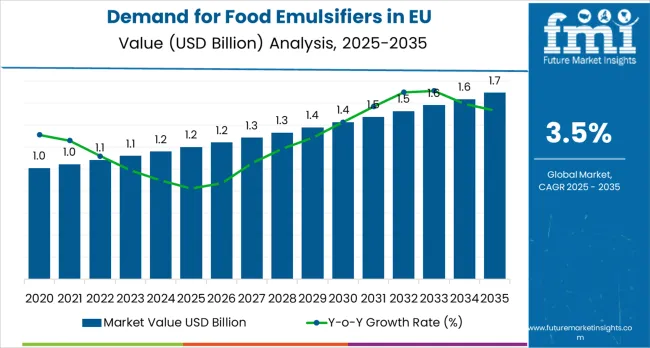
Between 2025 and 2030, the Demand for Food Emulsifiers in the EU is projected to expand from USD 1.20 billion to USD 1.45 billion, resulting in a value increase of USD 0.25 billion, which represents 50.0% of the total forecast growth for the decade.
This phase of growth will be shaped by accelerating clean-label food trends across European food manufacturing markets, increasing consumer awareness of natural ingredient benefits and emulsifier functionality, growing adoption of plant-based food formulations requiring specialized emulsification solutions, and expansion of food processing infrastructure in Eastern European economies.
Manufacturers are developing innovative product formulations including natural plant-derived emulsifiers, clean-label alternatives, enhanced functional properties, and sustainable processing technologies to address evolving European consumer preferences for ingredient transparency, natural origin, processing efficiency, and environmental responsibility.
From 2030 to 2035, the market is forecast to grow from USD 1.45 billion to USD 1.70 billion, adding another USD 0.25 billion, which constitutes 50.0% of the ten-year expansion. This period is expected to be characterized by widespread adoption of advanced emulsification technologies across mainstream European food processing channels, integration of precision formulation systems for enhanced product development, development of application-specific emulsifiers targeting bakery and dairy markets, and expansion of premium natural and specialty product segments.
The growing emphasis on clean-label ingredients in European food systems, increasing food technologist recommendations for natural emulsification solutions, stringent EU regulations supporting food safety and ingredient transparency, and rising health consciousness across European consumer segments will drive sustained demand for functionally superior, naturally derived, and sustainably produced food emulsifier solutions.
Between 2020 and 2025, the Demand for Food Emulsifiers in EU experienced steady expansion, driven by evolving food processing trends that positioned food emulsifiers as essential components for texture optimization, shelf-life extension, and product stability enhancement.
The market developed as European food manufacturers and ingredient companies recognized functional opportunities in high-performance, clean-label, and specialty emulsifier formats that appealed to quality-conscious consumers and food technologists seeking optimal processing characteristics and ingredient transparency for their food applications.
Major multinational ingredient suppliers expanded production capacity through strategic capital investments in European facilities, while regional players developed specialized emulsification techniques addressing specific functional requirements and clean-label standards across diverse national food markets within the European Union.
Market expansion is being supported by the fundamental shift in consumer attitudes toward clean-label food ingredients and natural processing solutions across European societies, with food emulsifiers increasingly regarded as essential food processing aids deserving premium functional performance, natural sourcing methods, and food quality comparable to traditional ingredient standards while providing unique texture and stability advantages.
Modern European food manufacturers and food technologists consistently prioritize ingredient functionality, natural origin, processing effectiveness, and regulatory compliance when selecting food emulsifiers, driving demand for specialty emulsifier formulations that deliver superior functional performance, naturally derived processing methods, exceptional texture properties, and clean-label certifications compared to synthetic food additives.
Even minor concerns about ingredient transparency, functional performance, or clean-label requirements can drive comprehensive adoption of specialized premium food emulsifiers designed to maintain optimal food quality, support specific processing applications, and enhance consumer satisfaction throughout all food manufacturing categories.
The growing complexity of food processing technology and increasing awareness of emulsifier-specific functional benefits are driving demand for technically advanced food emulsifier products from certified European manufacturers with appropriate food grade certifications, processing capabilities, technical expertise, and compliance with stringent EU food safety regulations.
Regulatory authorities across European Union member states are increasingly establishing comprehensive guidelines for food emulsifier manufacturing, functional claim accuracy, ingredient labeling standards, and food safety requirements to ensure product effectiveness and consumer safety.
Scientific research studies and application testing conducted at European food science research institutions are providing evidence supporting food emulsifier interventions for common food processing challenges including texture optimization, stability enhancement, shelf-life extension, and product quality improvement, requiring specialized processing expertise and food-grade production processes that meet EU food safety standards.
The industry is segmented by source, product type, application, and sales region. By source, the market is divided into plant-derived emulsifiers (including lecithin from soy and sunflower, and other plant-based emulsifiers) and animal-derived emulsifiers (including mono and di-glycerides from animal fats and other animal-sourced emulsifiers). Based on product type, the market is categorized into lecithin (including soy lecithin, sunflower lecithin), mono & di-glycerides derivatives, sorbitan esters, polyglycerol esters, stearoyl lactylates, and others.
By application, the market covers bakeries (including bread, cakes, and pastries), confectioneries (including chocolate, candies), dairy products, functional foods, salads & sauces, infant formula, and other food applications. Regionally, the market covers Germany, France, Italy, Spain, Netherlands, and Rest of Europe.
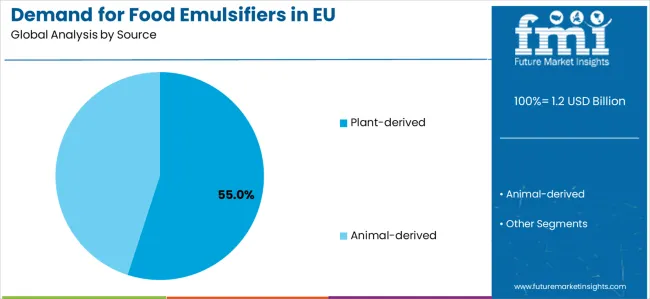
Plant-derived emulsifiers segment is projected to account for 55.0% of the Demand for Food Emulsifiers in EU in 2025, establishing itself as the dominant source category across European food processing and manufacturing facilities. This commanding market position is fundamentally supported by the widespread adoption of natural plant-based emulsifiers for clean-label food applications, enhanced consumer acceptance, and sustainable sourcing practices that deliver exceptional functional performance, superior consumer appeal, and unparalleled environmental responsibility throughout large-scale commercial food operations across EU member states.
Plant-derived emulsifier products provide European food manufacturers with unparalleled clean-label positioning, precise functional control during manufacturing processes, enhanced consumer acceptance, and seamless integration with natural food processing approaches that comply with stringent EU clean-label and environmental directives. This product sophistication enables European ingredient suppliers to achieve optimal market positioning while maintaining rigorous sustainability protocols mandated by European environmental regulations, comprehensive traceability systems required under EU law, and consistent functional performance across millions of individual food processing applications produced annually.
The segment derives substantial competitive advantages from established European plant-based ingredient infrastructure offering specialized extraction solutions, comprehensive technical support services, and continuous product innovation that incorporates advanced natural processing technologies, improved sustainability characteristics, and enhanced functional capabilities aligned with clean-label food processing standards. the plant-derived systems deliver superior market positioning particularly important in health-conscious food markets, enhanced consumer acceptance profiles, improved environmental compliance, and superior regulatory alignment with EU sustainability manufacturing standards.
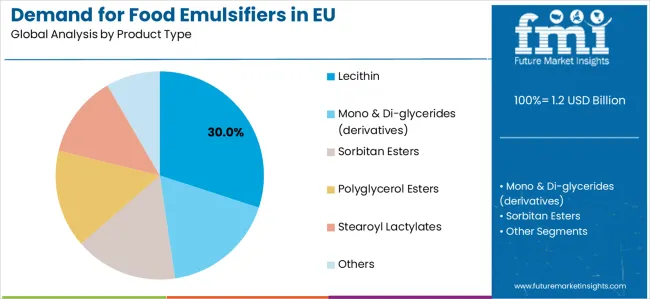
Bakeries applications are positioned to represent 30.0% of total European food emulsifier demand in 2025, reflecting the segment's dominant position within the market ecosystem and the substantially larger baking industry consumption patterns compared to other application categories across most European countries.
This substantial market share directly demonstrates the exceptionally high adoption rates of emulsifiers among European bakery manufacturers and the continuously expanding population of commercial bakeries and artisanal baking operations across both Western and Eastern European markets. Modern European bakery emulsifier applications are increasingly featuring sophisticated formulations that deliver enhanced dough handling properties, improved shelf-life characteristics, and specialized functional attributes specifically designed to address common baking challenges including texture optimization, moisture retention, volume enhancement, and crumb structure improvement.
European bakery manufacturers consistently demonstrate willingness to invest substantially in premium emulsifiers that deliver visible baking benefits, support optimal product outcomes, comply with EU food safety standards, and provide consistent results for both large-scale commercial bakery production and artisanal baking operations. Within the bakeries segment, bread applications command 18% share, cakes represent 8%, and pastries account for 4%, reflecting comprehensive application segmentation strategies tailored to European bakery market preferences.
The Demand for Food Emulsifiers in EU is advancing steadily due to intensifying clean-label trends and growing recognition of natural ingredient benefits across EU member states. The market faces challenges, including fluctuating raw material prices for natural emulsifier sources, complex clean-label regulations across diverse European jurisdictions, varying functional performance requirements across different food applications, competition from alternative texturizing agents, including hydrocolloids and protein-based solutions, and varying food manufacturer awareness levels regarding emulsifier functionality despite growing clean-label trends.
Innovation initiatives, sustainable sourcing programs, functional enhancement solutions, and clean-label platforms continue to influence product development strategies and market evolution patterns across European food markets.
The rapidly accelerating adoption of clean-label principles and natural ingredient preferences is fundamentally enabling broader market acceptance across European countries, enhanced consumer trust among food buyers particularly regarding ingredient transparency and natural sourcing, and significantly improved product positioning through certified natural emulsifier applications.
Advanced clean-label platforms operated by specialized food ingredient organizations, professional food technologists, and major food manufacturers equipped with comprehensive ingredient documentation in multiple European languages, natural sourcing certifications, processing guides, and application recommendations provide extensive technical resources while dramatically expanding ingredient credibility across diverse food processing segments and geographic markets throughout the European Union.
These clean-label trends prove particularly valuable for food emulsifiers that require detailed ingredient transparency documentation, natural sourcing verification, and targeted food processing approaches to effectively communicate complex functional benefits and justify premium pricing positions across sophisticated European health-conscious food segments.
Clean-label adoption also enables sophisticated ingredient analytics, personalized formulation recommendations based on specific processing requirements and consumer preferences, direct food manufacturer feedback collection that informs product development, and natural ingredient models that ensure consumer acceptance while reducing formulation complexity across fragmented European food markets.
Progressive European food emulsifier manufacturers are systematically incorporating innovative processing technologies including nano-emulsification, microencapsulation, controlled release systems, and functional enhancement that address growing European food industry demands for superior functional profiles, consistent processing performance, and enhanced application versatility in food processing systems.
Strategic integration of these advanced processing technologies, combined with rigorous functional testing and validation protocols conducted at European food science institutions, enables manufacturers to develop differentiated functional propositions that appeal to performance-conscious European food processors while maintaining essential safety characteristics and clean-label compliance.
These technological initiatives also support development of specialized formulations for specific food applications increasingly recognized across European markets, enhanced functional options for demanding processing environments recommended by European food technologists, and naturally-derived products that resonate with clean-label consumer segments particularly prevalent in Nordic and Western European countries.
Technology investments in processing enhancement facilities established in Netherlands and Germany, precision functional development capabilities, and advanced emulsifier processing technologies enable European manufacturers to explore next-generation food ingredients while maintaining competitive positioning in premium and high-performance market segments.
European food manufacturers and emulsifier suppliers are increasingly prioritizing sustainable sourcing and environmental compliance when selecting food emulsifiers, driving fundamental changes in sourcing strategies across the European food emulsifier industry.
Companies are implementing comprehensive sustainable agriculture programs using certified sustainable farming practices for plant-based emulsifier sources, reducing environmental impact through efficient processing technologies, and developing environmentally responsible supply chains that align with EU sustainability directives and corporate environmental responsibility regulations. This trend is particularly pronounced across Nordic countries, Germany, Netherlands, and France where food manufacturers demonstrate exceptional environmental consciousness and willingness to invest in ingredients with verified sustainability credentials and environmental compliance documentation.
Manufacturers are responding by developing partnerships with certified sustainable ingredient suppliers, implementing environmental management programs, obtaining multiple sustainability certifications including sustainable agriculture standards and carbon-neutral production, and providing comprehensive environmental impact information that differentiates their products in increasingly competitive European markets emphasizing environmental responsibility and sustainable sourcing commitments.
The Demand for Food Emulsifiers in EU is projected to grow from USD 1.20 billion in 2025 to USD 1.70 billion by 2035, registering a CAGR of 3.5% over the forecast period. Germany is expected to maintain its leadership with a 32.1% share in 2025, supported by its expansive food processing infrastructure and strong tradition of advanced food technology adoption.
Spain follows with an 18.6% market share, attributed to growing demand for food processing solutions and bakery applications. France contributes 16.2% of the market, driven by increasing adoption in confectionery and specialty food processing applications. Italy accounts for 11.2% of the market, while Netherlands represents 8.6%. The Rest of Europe region holds the remaining market share, encompassing Nordic countries, Eastern Europe, and other EU member states with established demand for food emulsifier products.
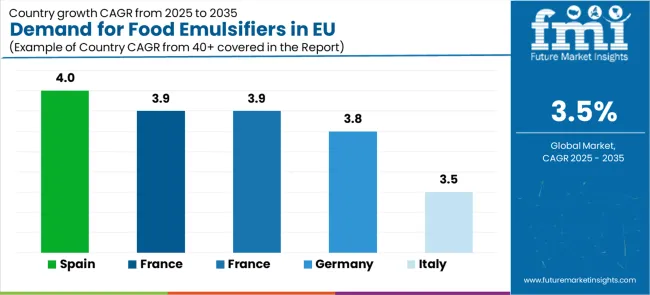
| Country | CAGR (2025-2035) |
|---|---|
| Spain | 4.0% |
| France | 3.9% |
| Netherlands | 3.9% |
| Germany | 3.8% |
| Italy | 3.5% |
The Demand for Food Emulsifiers in EU demonstrates consistent growth across major economies, with Spain leading at a 4.0% CAGR through 2035, driven by expanding food processing sectors and growing bakery applications. France and the Netherlands follow at 3.9%, supported by confectionery innovation and sustainable food processing practices. Germany maintains steady growth at 3.8%, leveraging its established food processing infrastructure. Italy shows moderate growth at 3.5%, focusing on traditional food processing enhancement. Rest of Europe grows at 2.7%, reflecting steady market development. The Germany maintains its leadership position while Spain demonstrates the strongest growth momentum.
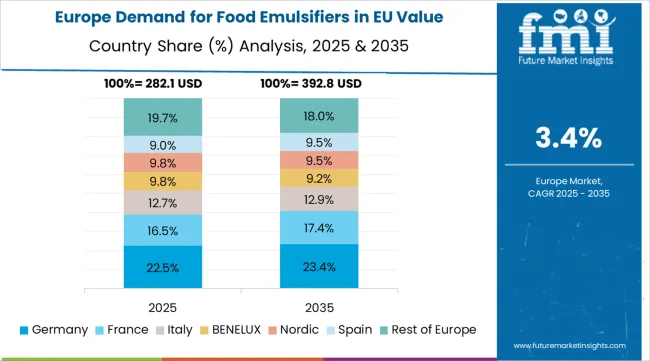
The food emulsifiers industry in Germany is projected to exhibit steady growth with a CAGR of 3.8% through 2035, driven by exceptionally strong food processing tradition and industrial infrastructure, comprehensively well-established distribution networks for food ingredients and processing materials, and sophisticated regulatory frameworks supporting food ingredient quality standards throughout the country. Germany's advanced food safety regulations and internationally recognized processing standards through organizations including German Food Technology Association are creating substantial demand for certified premium food emulsifiers across diverse professional and industrial food segments.
Major food processing companies including German food manufacturers, specialized ingredient processors including industrial food companies, and professional distribution networks are systematically establishing extensive ingredient portfolios serving both large-scale food manufacturers and specialty food processors throughout German production centers, manufacturing areas, and research communities. The German market benefits from exceptionally high food processing technology standards, substantial food manufacturing industry presence, strong ingredient supply chain programs delivering quality at competitive pricing, and industrial emphasis on technical excellence that naturally support premium food emulsifier adoption.
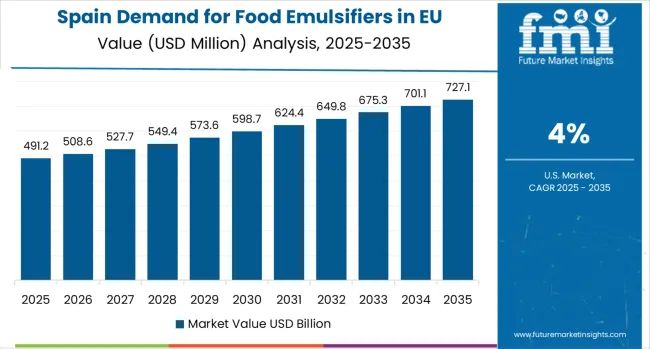
The food emulsifiers industry in Spain is expanding at a strong CAGR of 4.0%, substantially supported by rapidly expanding food processing sector that actively promotes advanced emulsification applications, increasing Spanish food industry modernization initiatives, and growing food manufacturing particularly in major industrial regions including Catalonia, Valencia, Andalusia, and Madrid areas. Spanish food processing sector is experiencing significant modernization with expansion of food manufacturers, premium ingredient suppliers, and major food distributors systematically increasing emulsifier category investments and introducing advanced processing capabilities.
The Spanish market is increasingly characterized by food industry modernization trends reflecting broader European patterns, growing interest in emulsifier formulations addressing specific processing applications, and increasing acceptance of technology investments for ingredients delivering visible processing benefits. Spain's substantial food export potential, strong cultural appreciation for food quality innovation reflecting Mediterranean values, and expanding food processing infrastructure create favorable conditions for food emulsifier market expansion.
The food emulsifiers industry in France is expanding at a steady CAGR of 3.9%, fundamentally driven by increasing integration of emulsifiers into traditional French food processing patterns, growing recognition of confectionery enhancement benefits, and strong French cultural appreciation for food quality and culinary excellence values. France's deeply established food culture is systematically incorporating specialized emulsifiers to enhance traditional food processing, improve product quality, and modernize classic French food manufacturing approaches while maintaining authentic culinary characteristics.
Professional food manufacturers, specialized ingredient distributors including French suppliers, leading food retailers (major French food groups), and traditional ingredient suppliers are strategically investing in processing programs and technical demonstrations addressing growing French interest in emulsifier solutions. The French market particularly benefits from strong cultural appreciation for food quality, traditional culinary approaches reflecting established French gastronomic traditions, and growing food processing capacity particularly in major French regions supporting premium ingredient adoption.
Demand for Food Emulsifiers in EU in the Netherlands is expanding at a robust CAGR of 3.9%, fundamentally driven by exceptionally strong Dutch commitment to sustainable food processing innovation, premium ingredient solutions, and environmental consciousness that positions Netherlands among European sustainable food processing leaders. Dutch food processors and ingredient manufacturers are increasingly selecting food emulsifiers based on comprehensive sustainability credentials, verified environmental production through European standards, and complete documentation demonstrating functional benefits and environmental profiles throughout food manufacturing processes.
The Netherlands market significantly benefits from exceptionally well-developed food processing research infrastructure including major food technology companies, specialized emulsifier suppliers, and professional sustainable distribution networks, combined with demonstrated willingness to invest substantial resources in emulsifiers with verified sustainability certifications and performance standards. Dutch regulatory environment actively supports food processing innovation, emulsifier research development, transparent environmental claim requirements, and sustainability validation initiatives that enhance food industry confidence and market development.
The food emulsifiers industry in Italy is growing at a consistent CAGR of 3.5%, fundamentally driven by gradual integration of emulsifiers into traditional Italian food processing patterns, growing recognition of food quality enhancement benefits, and strong Italian cultural appreciation for authentic food production methods and traditional manufacturing values. Italy's established food culture is systematically incorporating specialized emulsifiers to enhance traditional food processing, improve product quality, and modernize Italian food manufacturing approaches while maintaining authentic regional food characteristics.
Professional food manufacturers, specialized ingredient distributors including Italian suppliers, leading food retailers (major Italian food groups), and traditional ingredient suppliers are strategically investing in processing programs and technical training addressing growing Italian food industry interest in emulsifier solutions. The Italian market particularly benefits from strong cultural appreciation for food authenticity, traditional food production approaches reflecting established Italian culinary traditions, and growing food processing capacity particularly in Northern Italian regions supporting premium ingredient adoption.
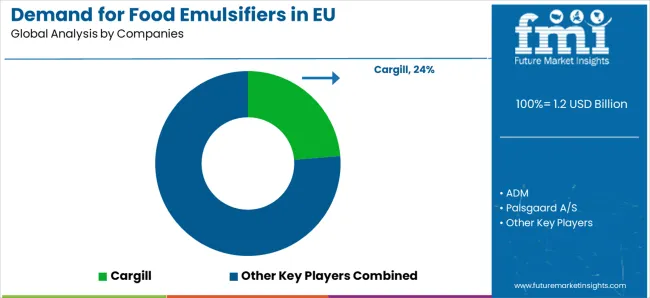
The Demand for Food Emulsifiers in EU is defined by moderate competition among multinational food ingredient corporations, regional European manufacturers, specialized emulsifier producers, and food technology companies from established ingredient suppliers. Companies are investing in European processing capacity expansion, clean-label emulsifier technologies, sustainable ingredient sourcing development through European innovation centers, natural ingredient solutions aligned with EU food regulations, and professional food industry distribution platforms serving diverse European food processing markets.
Strategic partnerships, product portfolio expansion, geographic market penetration across Western European growth markets, professional food industry partnership programs, and clean-label certifications are central to strengthening market position and capturing share in this established European category.
Major market participants include Cargill with significant European market presence through strong plant-based ingredient capabilities and comprehensive emulsifier solutions distributed through European food manufacturing channels. ADM maintains substantial European market leadership through lecithin specialization and global scale applications across food processing sectors including bakery, confectionery, and dairy markets.
Palsgaard A/S emphasizes clean label specialty technologies and technical support services for professional food manufacturers across European markets. Kerry Group represents significant European functional innovation capabilities with specialized emulsification solutions and comprehensive food processing technologies.
Regional European producers and specialized ingredient brands are establishing market presence through premium positioning, clean-label certifications, specialty emulsifier formulations including natural alternatives and functional-enhanced options, and direct-to-manufacturer business models.
Clean-label programs from major European food initiatives including established natural ingredient programs provide transparently sourced alternatives supporting market development, capturing market share particularly in health-conscious food processing markets. European co-processing specialists including specialized ingredient processors operate production facilities serving both branded manufacturers and food industry customers, representing infrastructure enabling market expansion and product innovation across European food processing markets.
| Item | Value |
|---|---|
| Quantitative Units | USD 1.70 billion |
| Source | Plant-derived, Animal-derived |
| Product Type | Lecithin, Mono & Di-glycerides, Sorbitan Esters, Polyglycerol Esters, Stearoyl Lactylates, Others |
| Application | Bakeries, Confectioneries, Dairy Products, Functional Foods, Salads & Sauces, Infant Formula, Others |
| Countries Covered | Germany, France, Italy, Spain, Netherlands, Rest of Europe |
| Key Companies Profiled | Cargill, ADM, Palsgaard A/S, Kerry Group, Ingredion, BASF, Corbion, Riken Vitamin, Lasenor, European Regional Producers |
| Additional Attributes | Dollar sales by source, product type, and application, regional demand trends across Western and Eastern European food processing markets, competitive landscape analysis with multinational corporations and specialized European ingredient brands, food manufacturer preferences for plant-derived versus animal-derived formulations and clean-label requirements, integration with European clean-label trends and sustainable food processing strategies, innovations in emulsification technologies and natural ingredient solutions aligned with EU food safety regulations, adoption of professional distribution models and specialized food ingredient networks across EU markets, regulatory framework analysis and food ingredient safety standards, supply chain optimization strategies including sustainable ingredient sourcing partnerships, and market penetration analysis for diverse food processing segments and geographic regions throughout European Union member states. |
The global demand for food emulsifiers in EU is estimated to be valued at USD 1.2 billion in 2025.
The market size for the demand for food emulsifiers in EU is projected to reach USD 1.7 billion by 2035.
The demand for food emulsifiers in EU is expected to grow at a 3.5% CAGR between 2025 and 2035.
The key product types in demand for food emulsifiers in EU are plant-derived and animal-derived .
In terms of product type, lecithin segment to command 30.0% share in the demand for food emulsifiers in EU in 2025.






Full Research Suite comprises of:
Market outlook & trends analysis
Interviews & case studies
Strategic recommendations
Vendor profiles & capabilities analysis
5-year forecasts
8 regions and 60+ country-level data splits
Market segment data splits
12 months of continuous data updates
DELIVERED AS:
PDF EXCEL ONLINE
Demand Signal Repository Solutions Market Size and Share Forecast Outlook 2025 to 2035
Demand Side Management Market Size and Share Forecast Outlook 2025 to 2035
Demand Response Market Analysis - Size, Share, and Forecast Outlook 2025 to 2035
North America Shipping Supplies Market Trends – Innovations & Growth 2024-2034
Demand of Kozani Saffron in Greece Analysis - Size, Share & Forecast 2025 to 2035
Demand of No-acid Whey Strained Dairy Processing Concepts in European Union Size and Share Forecast Outlook 2025 to 2035
Demand for Bronte Pistachio in Italy Analysis - Size, Share & Forecast 2025 to 2035
Demand and Trend Analysis of Gaming Monitor in Japan Size and Share Forecast Outlook 2025 to 2035
Demand and Trend Analysis of Gaming Monitor in Korea Size and Share Forecast Outlook 2025 to 2035
Demand and Trend Analysis of Gaming Monitor in Western Europe Size and Share Forecast Outlook 2025 to 2035
Glycine Soja (Soybean) Seed Extract Market Size and Share Forecast Outlook 2025 to 2035
Demand and Trend Analysis of Yeast in Japan - Size, Share, and Forecast Outlook 2025 to 2035
Demand and Trends Analysis of Stevia in Japan Size and Share Forecast Outlook 2025 to 2035
Demand of Pistachio-based desserts & ingredients in France Analysis - Size, Share & Forecast 2025 to 2035
Japan Women’s Intimate Care Market Trends – Growth & Forecast 2024-2034
Western Europe Men’s Skincare Market Analysis – Forecast 2023-2033
Demand and Trend Analysis of Fabric Stain Remover in Korea Size and Share Forecast Outlook 2025 to 2035
Demand and Sales Analysis of Paper Cup in Japan Size and Share Forecast Outlook 2025 to 2035
Demand and Sales Analysis of Paper Cup in Korea Size and Share Forecast Outlook 2025 to 2035
Demand of MFGM-enriched Powders & RTDs in European Union Size and Share Forecast Outlook 2025 to 2035

Thank you!
You will receive an email from our Business Development Manager. Please be sure to check your SPAM/JUNK folder too.
Chat With
MaRIA